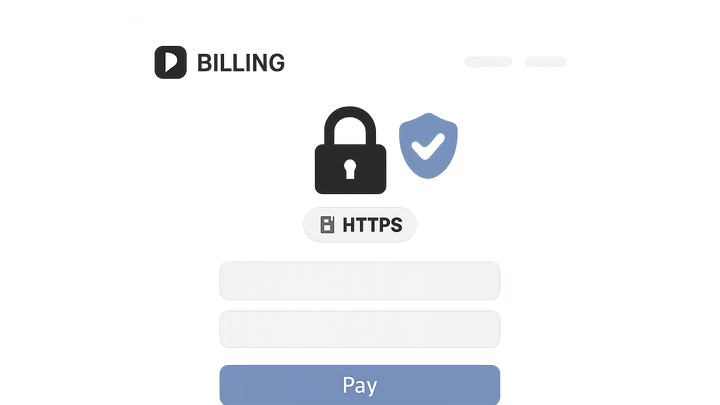Published on 2025-06-29T20:59:31Z
What is Billing Page Security? Examples and Best Practices
Billing Page Security encompasses the technical and UX measures that protect a user’s payment details during checkout. It involves:
- Encryption of data in transit and at rest;
- Adherence to PCI DSS and other compliance standards;
- Integration with secure payment gateways;
- Display of trust signals and security badges.
By securing the billing page, businesses can prevent fraud, reduce cart abandonment, foster user trust, and even boost SEO rankings through HTTPS. In a CRO and UX context, a clearly secure checkout experience is crucial for maximizing conversions and customer satisfaction.
Billing page security
Ensuring checkout page protects payment data via encryption, compliance, and trust signals for better CRO, UX & SEO.
Why Billing Page Security Matters
Billing Page Security is a critical factor in protecting customer data and ensuring transaction integrity. It influences user trust, regulatory compliance, and conversion rates.
-
Building customer trust
Users are more likely to complete a purchase when they see visible security indicators. Lack of trust signals can cause cart abandonment.
- Visible padlock icon:
Shows the connection is secure via HTTPS, reassuring users.
- Security badges:
Logos from trusted providers (e.g., Visa, MasterCard) reinforce credibility.
- Visible padlock icon:
-
Preventing fraud and data breaches
Strong security measures deter attackers and protect payment information from interception or theft.
- Data encryption:
Encrypts data in transit and at rest, making stolen information unreadable.
- Tokenization:
Replaces sensitive data with unique tokens, limiting exposure.
- Data encryption:
-
Compliance and legal requirements
Standards like PCI DSS mandate specific security protocols for handling payment data.
- Pci dss standards:
Define requirements for secure payment processing and data storage.
- Audit and reporting:
Regular assessments ensure ongoing compliance and identify gaps.
- Pci dss standards:
-
Seo and site performance
HTTPS is a ranking factor for SEO, and secure pages often load faster, improving UX and search visibility.
- Https ranking boost:
Search engines favor secure sites, potentially improving rankings.
- Page speed:
Security measures should be optimized to avoid slowing down the checkout process.
- Https ranking boost:
Core Components of Billing Page Security
To effectively secure a billing page, implement a combination of technical safeguards, compliance practices, and user-facing trust elements.
-
Ssl/tls encryption
Enables secure communication between the user’s browser and your server to protect data in transit.
- Valid ssl certificate:
Issued by a trusted CA to authenticate your domain.
- Latest tls protocols:
Use TLS 1.2 or 1.3 for optimal security.
- Valid ssl certificate:
-
Pci dss compliance
A set of security standards for organizations handling credit card information.
- Data storage limitations:
Avoid storing sensitive cardholder data unless absolutely necessary.
- Regular penetration tests:
Identify vulnerabilities before attackers can exploit them.
- Data storage limitations:
-
Payment gateway integration
Use reputable gateways to process transactions securely without exposing raw payment data.
- Tokenization services:
Replaces card details with tokens to reduce risk.
- 3d secure authentication:
Adds an extra verification layer, like Visa Secure or Mastercard Identity Check.
- Tokenization services:
-
Data encryption at rest
Encrypt customer data stored on servers and databases to safeguard against breaches.
- Database encryption:
Encrypts sensitive columns or entire databases.
- Key management:
Store encryption keys securely, separate from the data.
- Database encryption:
Best Practices for Implementing Billing Page Security
Follow these CRO, UX, and SEO-friendly practices to ensure a secure and conversion-optimized billing page.
-
Display trust signals
Show security badges, SSL seals, and privacy policy links prominently to reassure users.
- Placement above the fold:
Position badges near payment fields for immediate visibility.
- Privacy policy link:
Offer transparent information on data usage to build trust.
- Placement above the fold:
-
Optimize page load speed
Security shouldn’t compromise performance; optimize assets and use CDNs for fast load times.
- Minimize http requests:
Combine scripts and styles where possible to reduce load times.
- Use content delivery networks:
Accelerate asset delivery for global users.
- Minimize http requests:
-
Conduct regular security audits
Automated and manual testing helps catch emerging threats and misconfigurations.
- Automated vulnerability scans:
Schedule periodic scans for known issues.
- Manual penetration testing:
Engage experts to simulate real-world attacks.
- Automated vulnerability scans:
-
Monitor and update dependencies
Keep libraries, plugins, and frameworks up to date to patch security flaws promptly.
- Version control:
Track changes and roll back if updates cause issues.
- Automated alerts:
Receive notifications for new vulnerabilities.
- Version control:
Leveraging Prevue.me for Billing Page Security Insights
prevue.me offers automated critiques and actionable insights to tighten your billing page security while aligning with CRO, UX, and SEO objectives.
-
Automated security analysis
Scans your billing page for SSL/TLS issues, header misconfigurations, and outdated libraries.
- Real-time ssl checks:
Validates certificate validity and protocol support instantly.
- Header security tests:
Evaluates HSTS, CSP, and other critical headers for best practices.
- Real-time ssl checks:
-
Actionable recommendations
Provides prioritized fixes with step-by-step guidance tailored to your tech stack.
- Code snippets:
Offers example implementations for common vulnerabilities.
- Risk prioritization:
Helps focus on high-impact issues to boost security and conversions.
- Code snippets:
-
Ux and seo integration
Shows how security improvements can enhance user flow and search visibility simultaneously.
- Conversion impact analysis:
Predicts how security enhancements may reduce cart abandonment.
- Seo health checks:
Assesses HTTPS status, canonical tags, and mobile performance in one review.
- Conversion impact analysis:
